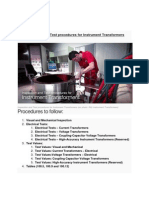Switchgears and Switchboard Assemblies
Uploaded by
Honeylyn IgnacioSwitchgears and Switchboard Assemblies
Uploaded by
Honeylyn IgnacioSwitchgears and switchboard assemblies
1. Visual and Mechanical Inspection
1. Compare equipment nameplate data with drawings and specifications.
2. Inspect physical and mechanical conditions.
3. Inspect anchorage, alignment, grounding and required area clearances.
4. Verify the unit is clean.
5. Verify the fuse and/or circuit breaker sizes and types correspond to drawings and
coordination study as well as to the circuit breakers address for microprocessor-
communication packages.
6. Verify that current and voltage transformer ratio corresponds to drawings
7. Inspect bolted electrical connections for high resistance using one of the following methods.
1. Use of low-resistance ohmmeter in accordance with Section 7.1.2.3.
2. Verify tightness of accessible bolted electrical connections by calibrated torque
wrench method in accordance with manufacturer’s published data or table 100.12.
3. Perform thermo graphic survey in accordance with section 9.
8. Confirm correct operation and sequencing of electrical and mechanical interlock systems.
1. Attempt closure on locked-open devices. Attempt to open locked-closed devices.
2. Make key exchange with devices operated in off-normal positions.
9. Lubrication requirements
1. Verify appropriate lubrication on moving current carrying parts.
2. Verify appropriate lubrication on moving and sliding surfaces.
10. Inspect insulators for evidence of physical damage or contaminated surfaces.
11. Verify correct barrier and shutter installation and operation.
12. Exercise all active components.
13. Inspect mechanical indicating devices for correct operation.
14. Verify that filters are in place and/or vents are clear.
15. Perform visual and mechanical inspection of instrument transformers in accordance with
Section 7.10.
16. Inspect control power transformers.
1. Inspect for physical damage, cracked insulation, broken leads, tightness of
connections, defective wiring, and overall condition.
2. Verify that primary and secondary fuse or circuit breakers ratings match drawings.
3. Verify correct functioning of draw out disconnecting and grounding contacts and
Interlocks.
2. Electrical Test.
1. Perform electrical tests on instrument transformers in accordance with section 7.10.
2. Perform ground-resistance test in accordance with section 7.13.
3. Perform resistance measurements through bolted electrical connections with a low
resistance ohmmeter, if applicable, In accordance with section 7.1.1.
4. Perform insulation-resistance test on each bus section, phase to phase and phase to ground
for one minute in accordance with table 100.1.
5. Perform an overpotential test on each bus section, each phase to ground with phases not
under
6. Test grounded, in accordance with manufacturers published data. If manufacturer has no
recommendation for this test, it shall be in accordance with table 100.2. The test applied for
one minute.
7. Perform system function tests in accordance with Section 8.
8. Perform current injection tests on the entire current circuit in each section of switchgear.
1. Perform current tests by secondary injection with magnitudes such that a minimum
of 1.0 ampere flows in the secondary circuit. Verify correct magnitude of current at
each device in the circuit.
2. Perform current tests by primary injection with magnitudes such that a minimum of
1.0 ampere flows in the secondary circuit. Verify correct magnitude of current at
each device in the circuit.
9. Determine accuracy of all meters and calibrate watt-hour meters in accordance with Section
7.11. Verify multipliers.
10. Perform phasing check on double-ended or dual-source switchgear to insure correct bus
phasing from each source.
11. Control Power Transformers
1. Perform insulation-resistance tests. Perform measurements from winding-to-
winding and each winding-to-ground. Test voltages shall be in accordance with
Table 100.1 unless otherwise specified by manufacturer.
2. Perform secondary wiring integrity test. Disconnect transformer at secondary
terminals and connect secondary wiring to a rated secondary voltage source. Verify
correct potential at all devices.
3. Verify correct secondary voltage by energizing primary winding with system voltage.
Measure secondary voltage with the secondary wiring disconnected.
4. Verify correct function of control transfer relays located in switchgear with multiple
control power source.
12. Voltage Transformers
1. Perform insulation-resistance tests. Perform measurements from winding-to-
winding and each winding-to-ground. Test voltages shall be in accordance with
Table 100.1 unless otherwise specified by manufacturer.
2. Perform secondary wiring integrity test. Verify correct potential at all devices.
3. Verify secondary voltages by energizing primary winding with system voltage.
13. Verify operation of cubicle switchgear/switchboard space heaters.
3. Test Values
1. Compare bus connection resistance to values of similar connections.
2. Bolt-torque levels should be in accordance with Table 100.12 unless otherwise specified
by manufacturer.
3. Microhm or millivolt drop values shall not exceed the high levels of the normal range as
indicated in the manufacturer’s published data. If manufacturer’s data is not available,
investigate any values which deviate from similar bus by more that 50 percent of the
lowest value.
4. Insulation-resistance values for bus and control power transformers shall be in
accordance with manufacturer’s published data. In the absence of manufacturer’s date,
use Table 100.1. Values of insulation resistance less than this table or manufacturer’s
minimum should be investigated. Overpotential tests should not proceed until insulation-
resistance levels are raised above minimum values.
5. Bus insulation shall withstand the overpotential test voltage applied.
6. Insulation-resistance values for control wiring shall be a minimum of 2.0 mega ohms.
ATS-2003.24
You might also like
- 7.3.2 Cables, Low-Voltage, 600-Volt MaximumNo ratings yet7.3.2 Cables, Low-Voltage, 600-Volt Maximum2 pages
- Instrument Transformers: 1. 1. Visual and Mechanical InspectionNo ratings yetInstrument Transformers: 1. 1. Visual and Mechanical Inspection2 pages
- Circuit Switchers: 1. Visual and Mechanical InspectionNo ratings yetCircuit Switchers: 1. Visual and Mechanical Inspection3 pages
- Circuit Breakers, Air, Low-Voltage PowerNo ratings yetCircuit Breakers, Air, Low-Voltage Power3 pages
- Switches Air, Medium - and High Voltage, OpenNo ratings yetSwitches Air, Medium - and High Voltage, Open3 pages
- Transformers, Dry Type, Air-Cooled, LargeNo ratings yetTransformers, Dry Type, Air-Cooled, Large4 pages
- NETA MTS 2007 - Instrument Transformer TestingNo ratings yetNETA MTS 2007 - Instrument Transformer Testing7 pages
- Inspection of Ground-Fault Protection SystemsNo ratings yetInspection of Ground-Fault Protection Systems3 pages
- Powell Apparatus Service Division: Instrument TransformersNo ratings yetPowell Apparatus Service Division: Instrument Transformers2 pages
- Inspection and Test Procedures For Instrument Transformers100% (1)Inspection and Test Procedures For Instrument Transformers9 pages
- Transformers, Dry Type, Air-Cooled, Low Voltage, SmallNo ratings yetTransformers, Dry Type, Air-Cooled, Low Voltage, Small2 pages
- Inspection and Test Procedures For Instrument Transformers - EEPNo ratings yetInspection and Test Procedures For Instrument Transformers - EEP11 pages
- Circuit Breakers, Air, Insulated-CaseMolded-CaseNo ratings yetCircuit Breakers, Air, Insulated-CaseMolded-Case3 pages
- Inspection AND Test Procedures 7.3.3 Cables, Medium-And High-VoltageNo ratings yetInspection AND Test Procedures 7.3.3 Cables, Medium-And High-Voltage4 pages
- Anybus Modbus To Bacnet Gateway DatasheetNo ratings yetAnybus Modbus To Bacnet Gateway Datasheet5 pages
- Field Inspection of New Medium-Voltage SwitchgearNo ratings yetField Inspection of New Medium-Voltage Switchgear3 pages
- Inspection and Test Procedures For MetalNo ratings yetInspection and Test Procedures For Metal5 pages
- Pages From Ansi-Neta-Accceptance Testing Specifications - 2009No ratings yetPages From Ansi-Neta-Accceptance Testing Specifications - 20092 pages
- Circuit Breakers SF6: 1. Visual and Mechanical InspectionNo ratings yetCircuit Breakers SF6: 1. Visual and Mechanical Inspection3 pages
- Field Inspection of New Medium Voltage SwitchgearNo ratings yetField Inspection of New Medium Voltage Switchgear3 pages
- Field Inspection and Testing of Medium-Voltage Motor Control Centres (MCCS)No ratings yetField Inspection and Testing of Medium-Voltage Motor Control Centres (MCCS)3 pages
- Metal-Enclosed Busways: 1. Visual and Mechanical InspectionNo ratings yetMetal-Enclosed Busways: 1. Visual and Mechanical Inspection3 pages
- Eep-Field Inspection and Testing of MediumVoltage Motor Control Centres MCCsNo ratings yetEep-Field Inspection and Testing of MediumVoltage Motor Control Centres MCCs4 pages
- General: Design Guidelines Technical Sections: All U-M Master Specifications: AllNo ratings yetGeneral: Design Guidelines Technical Sections: All U-M Master Specifications: All7 pages
- Field Inspection and Testing of MediumVoltage Motor Control Centres MCCNo ratings yetField Inspection and Testing of MediumVoltage Motor Control Centres MCC4 pages
- Inspection and Test Procedures For CableNo ratings yetInspection and Test Procedures For Cable6 pages
- Method-Statement for Testing and Commissioning of 33kV Outdoor SwitchyardNo ratings yetMethod-Statement for Testing and Commissioning of 33kV Outdoor Switchyard21 pages
- AC Circuit Breakers Routine Tests According To IEC 62271-100No ratings yetAC Circuit Breakers Routine Tests According To IEC 62271-10012 pages
- Inspection and Test Procedures For LV Cables100% (1)Inspection and Test Procedures For LV Cables5 pages
- Medium Voltage Switchgear Testing Method StatementNo ratings yetMedium Voltage Switchgear Testing Method Statement29 pages
- EDOC - 10 Critical Tests For New Power Circuit Breakers100% (1)EDOC - 10 Critical Tests For New Power Circuit Breakers7 pages
- T. in The Case of Current-Limiting Fuses, The Maximum Arc Energy May Occur at Current LevelsNo ratings yetT. in The Case of Current-Limiting Fuses, The Maximum Arc Energy May Occur at Current Levels20 pages
- Boat Maintenance Companions: Electrics & Diesel Companions at SeaFrom EverandBoat Maintenance Companions: Electrics & Diesel Companions at SeaNo ratings yet
- Emergency Shower and Eyewash Station: Your Security IS MY PromiseNo ratings yetEmergency Shower and Eyewash Station: Your Security IS MY Promise2 pages
- Notice of Readiness of Mechanical Completion: Pasar CorporationNo ratings yetNotice of Readiness of Mechanical Completion: Pasar Corporation12 pages
- Transformers, Liquid-Filled: 1. Visual and Mechanical InspectionNo ratings yetTransformers, Liquid-Filled: 1. Visual and Mechanical Inspection4 pages
- Protective Relays: 1. Visual and Mechanical InspectionNo ratings yetProtective Relays: 1. Visual and Mechanical Inspection4 pages
- Lead Acid Battery: Department of Electrical & Electronics EngineeringNo ratings yetLead Acid Battery: Department of Electrical & Electronics Engineering13 pages
- Synthesis and Characterization of Cadmium Sulphide NanoparticlesNo ratings yetSynthesis and Characterization of Cadmium Sulphide Nanoparticles17 pages
- Interfacing PIC Microcontroller With 7 Segment Display - MikroC CodeNo ratings yetInterfacing PIC Microcontroller With 7 Segment Display - MikroC Code5 pages
- 455 KHZ Oscillator Schematic 455 KHZ Oscillator Schematic: Read/Download: Read/Download33% (3)455 KHZ Oscillator Schematic 455 KHZ Oscillator Schematic: Read/Download: Read/Download3 pages
- TRAFINDO - 3D Oil-Immersed Transformer OptNo ratings yetTRAFINDO - 3D Oil-Immersed Transformer Opt2 pages
- Fulleon Fire Alarm Devices - Product CatalogueNo ratings yetFulleon Fire Alarm Devices - Product Catalogue1 page
- McGraw-Edison Hi-Mast Luminaires Brochure 1978100% (2)McGraw-Edison Hi-Mast Luminaires Brochure 197816 pages
- Ultra-Low-Power, 10Msps, Dual 8-Bit ADC: General Description FeaturesNo ratings yetUltra-Low-Power, 10Msps, Dual 8-Bit ADC: General Description Features22 pages
- Wideband Dipoles - Fan Dipoles: Microstrip AntennasNo ratings yetWideband Dipoles - Fan Dipoles: Microstrip Antennas13 pages
- Acoplador de Vínculo Aislado de Controlador SLC 500No ratings yetAcoplador de Vínculo Aislado de Controlador SLC 50012 pages
- Unit 8 Heating and Cooling of Electric Motors100% (1)Unit 8 Heating and Cooling of Electric Motors20 pages
- DC7xD Series Configuration and Instructions V1.3-180630No ratings yetDC7xD Series Configuration and Instructions V1.3-18063017 pages




































































































